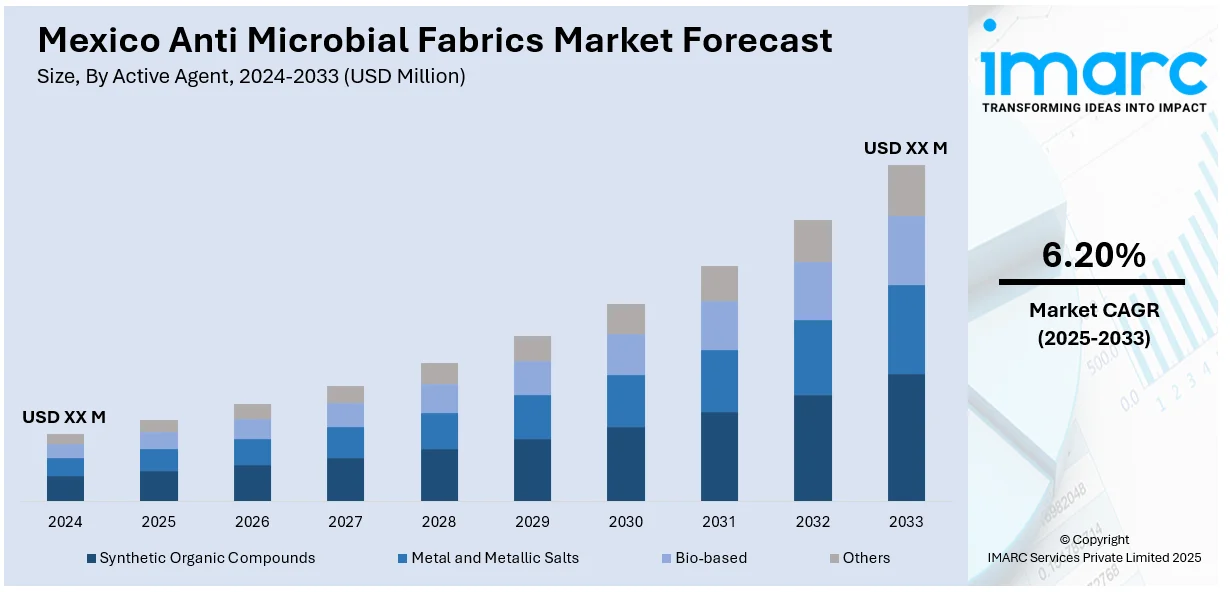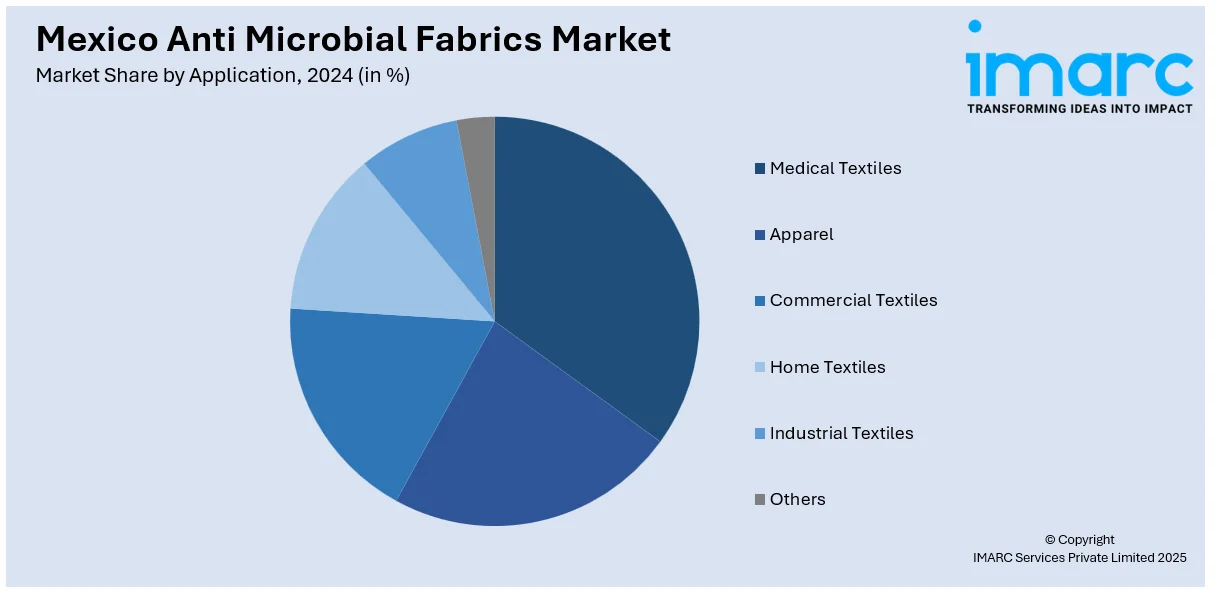
Mexico Anti Microbial Fabrics Market Size, Share, Trends and Forecast by Active Agent, Application, and Region, 2025-2033
Mexico Anti Microbial Fabrics Market Overview:
The Mexico anti microbial fabrics market size is projected to exhibit a growth rate (CAGR) of 6.20% during 2025-2033. The growth of the antimicrobial fabrics market in Mexico is driven by increasing healthcare infrastructure and a growing focus on infection control in hospitals boost demand for antimicrobial textiles in medical applications. Additionally, rising consumer awareness of hygiene and health contributes to the popularity of antimicrobial fabrics in everyday products like clothing and home textiles. The shift towards sustainability, with eco-friendly and bio-based fabric treatments, also plays a significant role in surging the Mexico anti microbial fabrics market share.
|
Report Attribute
|
Key Statistics
|
|---|---|
|
Base Year
|
2024 |
|
Forecast Years
|
2025-2033
|
|
Historical Years
|
2019-2024
|
| Market Growth Rate 2025-2033 | 6.20% |
Mexico Anti Microbial Fabrics Market Analysis:
- Major Market Drivers: Mexico anti microbial fabrics market demand is growing with rising hygiene consciousness in the healthcare, hospitality, and public sectors. Antimicrobial fabrics used as protective textiles in hospitals, sports centers, and transportation are gaining popularity to avert microbial development, driving up demand for long-lasting, high-performance fabrics treated with antimicrobial solutions.
- Key Market Trends: Some of the emerging trends involve the use of sustainable and environmental-friendly antimicrobial treatments, incorporation into smart textiles, and multifunctional fabrics with stain resistance, odor control, and UV protection. Companies emphasize innovation in order to address increasing consumer demands for safe, durable, and high-performance antimicrobial fabrics for various applications.
- Competitive Landscape: Key local and foreign companies are putting money into research and development for enhancing fabric durability, antimicrobial activity, and multifunctionality. Strategic partnerships, technology transfer, and domestic production expansion enable firms to enhance market presence and take advantage of new Mexico anti microbial fabrics market trends.
- Challenges and Opportunities: High manufacturing costs, rigorous regulatory requirements, and customer doubts concerning antimicrobial effectiveness are major challenges. Opportunity is present in the development of healthcare infrastructure, increasing awareness of hygiene, and the increasing demand for protective textiles, which has huge scope for future growth and innovation for antimicrobial textiles.
Mexico Anti Microbial Fabrics Market Trends:
Emphasis on Sustainability and Eco-friendly Solutions
The market is experiencing a trend towards more eco-friendly and sustainable antimicrobial fabric solutions. With growing concern regarding the environment, manufacturers and consumers are giving priority to textiles derived from biodegradable or renewable sources. Antimicrobial fabrics developed using natural agents such as tea tree oil, chitosan, or eucalyptus extract are becoming increasingly popular due to their environmental appeal. These materials not only minimize the environmental footprint but also address consumer need for more environmentally friendly choices in day-to-day products. With sustainable fashion and green technology remaining on the rise around the world, Mexican manufacturers are turning to ecologically friendly antimicrobial solutions to meet consumer values as well as global standards of sustainability, making the market for green antimicrobial fabrics grow in the next few years. This reflects the importance of Mexico anti microbial fabrics market analysis.

To get more information on this market, Request Sample
Growth in Healthcare Sector Demand
Mexico's healthcare sector has significantly influenced the demand for antimicrobial fabrics. With about 77% of the population covered by healthcare below the OECD average of 89% ongoing efforts to improve services are vital as per the March 2025 reports. The rise in healthcare-associated infections (HCAIs) and expansion of infrastructure has driven the adoption of antimicrobial textiles in hospital linens, surgical gowns, wound dressings, and protective wear. These fabrics help reduce pathogen transmission, aligning with the growing focus on hygiene and patient safety. As Mexico enhances healthcare access and addresses infection control challenges, especially in hospitals and clinics, the use of antimicrobial fabrics is expected to rise. The aging population further amplifies demand, as elderly care requires stringent hygiene standards. Overall, these trends support stable, long-term Mexico anti microbial fabrics market growth in healthcare sector.
Technological Advancements in Fabric Performance
The Mexican antimicrobial textile market is also receiving a boost from advances in technology that are improving the performance of textiles. Advances in nanotechnology, in general, have enabled antimicrobial chemicals to be incorporated at a molecular level, greatly enhancing the durability and efficacy of the textiles. These advances produce textiles that are not only antimicrobial in nature but also have additional benefits such as moisture wicking, ultraviolet (UV) resistance, and deodorant properties. Consequently, antimicrobial textiles are being utilized in a variety of industries outside of healthcare, including sportswear, fashion, and even home furnishings. The emergence of smart fabrics with multiple functional properties is an exciting new frontier, expanding the use of antimicrobial textiles and appealing to a more diverse consumer in Mexico. The future of this market is ever more tied to continued technological innovation, strengthening Mexico anti microbial fabrics market share across industries.
Mexico Anti Microbial Fabrics Market Segmentation:
IMARC Group provides an analysis of the key trends in each segment of the market, along with forecasts at the country and regional levels news for 2025-2033. Our report has categorized the market based on active agent and application.
Active Agents Insights:
- Synthetic Organic Compounds
- Metal and Metallic Salts
- Bio-based
- Others
The report has provided a detailed breakup and analysis of the market based on the active agent. This includes synthetic organic compounds, metal and metallic salts, bio-based, and others.
Application Insights:

- Medical Textiles
- Apparel
- Commercial Textiles
- Home Textiles
- Industrial Textiles
- Others
A detailed breakup and analysis of the market based on the application have also been provided in the report. This includes medical textiles, apparel, commercial textiles, home textiles, industrial textiles, and others.
Regional Insights:
- Northern Mexico
- Central Mexico
- Southern Mexico
- Others
The report has also provided a comprehensive analysis of all the major regional markets, which include Northern, Central, Southern Mexico, and Others.
Competitive Landscape:
The market research report has also provided a comprehensive analysis of the competitive landscape. Competitive analysis such as market structure, key player positioning, top winning strategies, competitive dashboard, and company evaluation quadrant has been covered in the report. Also, detailed profiles of all major companies have been provided.
Mexico Anti Microbial Fabrics Market News:
- In December 2024, Microban International launched Freshology™, a patent-pending, nature-inspired odor control technology. Designed to neutralize a wide range of odors, it helps keep textiles fresher for longer. Effective against common odorants like isovaleric acid, ammonia, and acetic acid, Freshology enhances moisture management and fabric softness. Integrated into synthetic materials such as polyester and nylon, it is nonionic, heavy metal-free, and mill-friendly, making it ideal for existing manufacturing processes.
Mexico Anti Microbial Fabrics Market Report Coverage:
| Report Features | Details |
|---|---|
| Base Year of the Analysis | 2024 |
| Historical Period | 2019-2024 |
| Forecast Period | 2025-2033 |
| Units | Million USD |
| Scope of the Report | Exploration of Historical Trends and Market Outlook, Industry Catalysts and Challenges, Segment-Wise Historical and Future Market Assessment:
|
| Active Agents Covered | Synthetic Organic Compounds, Metal and Metallic Salts, Bio-based, Others |
| Applications Covered | Medical Textiles, Apparel, Commercial Textiles, Home Textiles, Industrial Textiles, Others |
| Regions Covered | Northern Mexico, Central Mexico, Southern Mexico, Others |
| Customization Scope | 10% Free Customization |
| Post-Sale Analyst Support | 10-12 Weeks |
| Delivery Format | PDF and Excel through Email (We can also provide the editable version of the report in PPT/Word format on special request) |
Key Questions Answered in This Report:
- How has the Mexico anti microbial fabrics market performed so far and how will it perform in the coming years?
- What is the breakup of the Mexico anti microbial fabrics market on the basis of active agent?
- What is the breakup of the Mexico anti microbial fabrics market on the basis of application?
- What is the breakup of the Mexico anti microbial fabrics market on the basis of region?
- What are the various stages in the value chain of the Mexico anti microbial fabrics market?
- What are the key driving factors and challenges in the Mexico anti microbial fabrics market?
- What is the structure of the Mexico anti microbial fabrics market and who are the key players?
- What is the degree of competition in the Mexico anti microbial fabrics market?
Key Benefits for Stakeholders:
- IMARC’s industry report offers a comprehensive quantitative analysis of various market segments, historical and current market trends, market forecasts, and dynamics of the Mexico anti microbial fabrics market from 2019-2033.
- The research report provides the latest information on the market drivers, challenges, and opportunities in the Mexico anti microbial fabrics market.
- Porter's five forces analysis assist stakeholders in assessing the impact of new entrants, competitive rivalry, supplier power, buyer power, and the threat of substitution. It helps stakeholders to analyze the level of competition within the Mexico anti microbial fabrics industry and its attractiveness.
- Competitive landscape allows stakeholders to understand their competitive environment and provides an insight into the current positions of key players in the market.
Need more help?
- Speak to our experienced analysts for insights on the current market scenarios.
- Include additional segments and countries to customize the report as per your requirement.
- Gain an unparalleled competitive advantage in your domain by understanding how to utilize the report and positively impacting your operations and revenue.
- For further assistance, please connect with our analysts.
 Request Customization
Request Customization
 Speak to an Analyst
Speak to an Analyst
 Request Brochure
Request Brochure
 Inquire Before Buying
Inquire Before Buying




.webp)




.webp)












